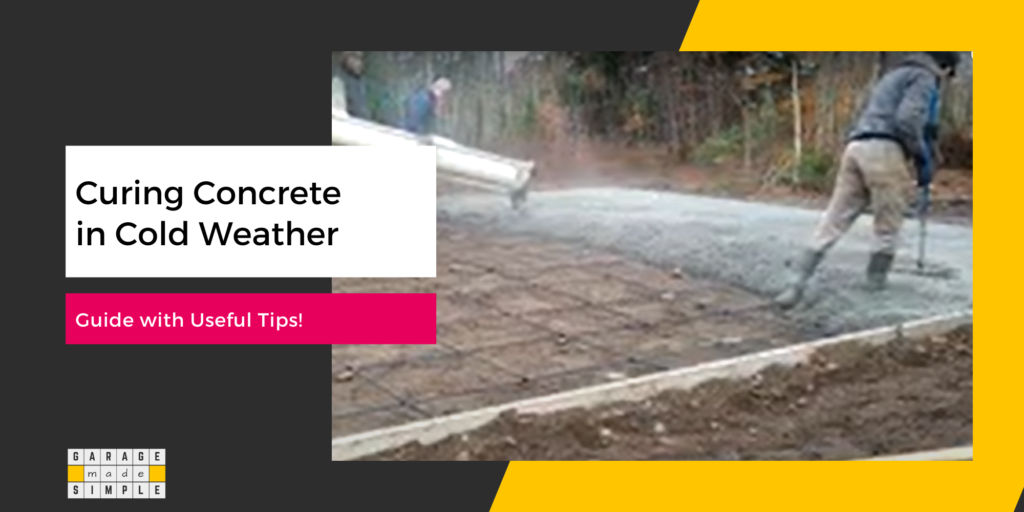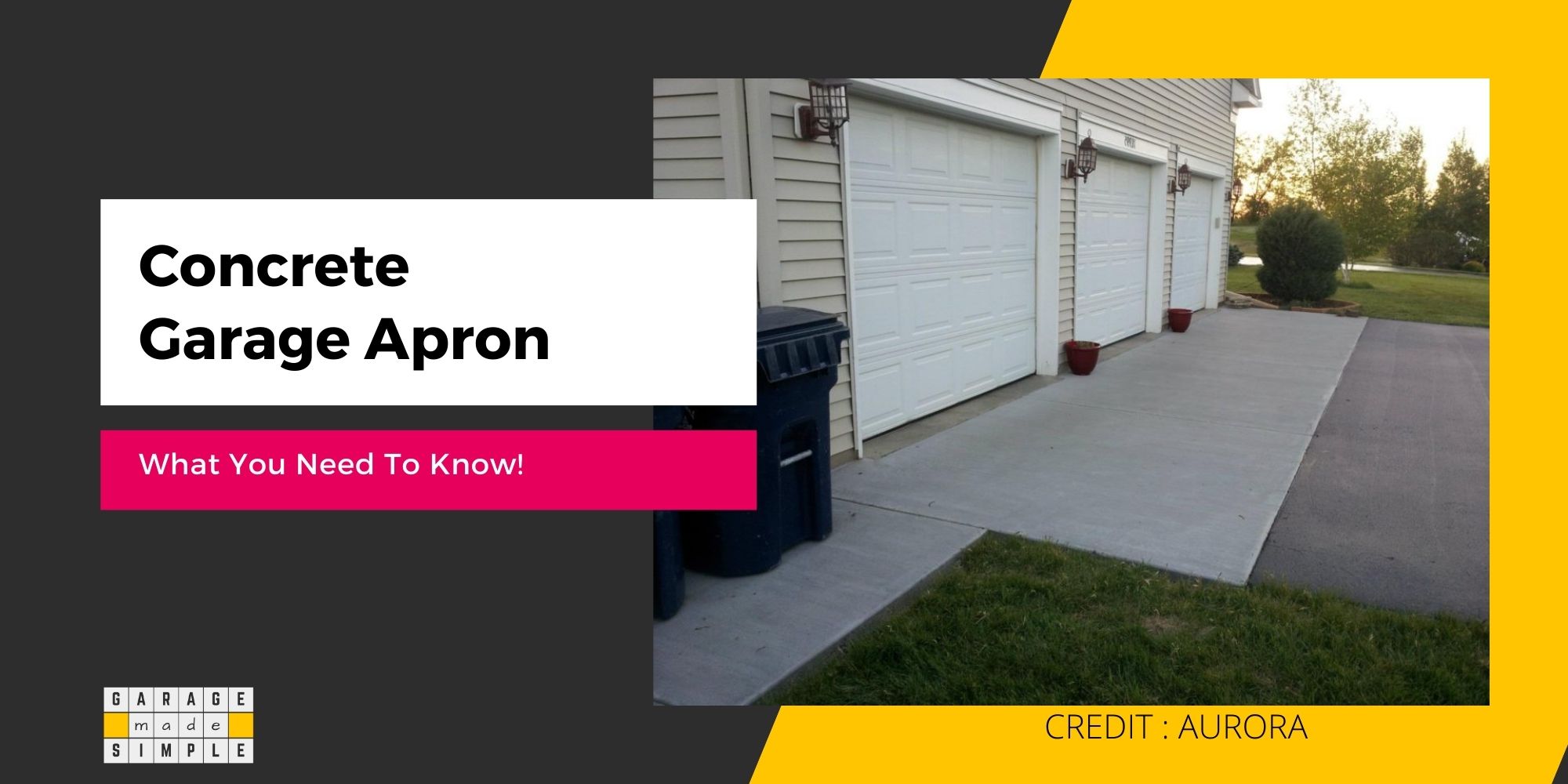11 Tips for Curing Concrete in Cold Weather: A Useful Guide!
garagemadesimple.com is a participant in the Amazon Services LLC Associates Program, an affiliate advertising program designed to provide a means for sites to earn advertising fees by advertising and linking to Amazon.com . The website is also an affiliate of a few other brands.
How Cold Is Too Cold for Curing Concrete?
Planning to pour the concrete slab on grade for your garage in winter? Curing concrete in cold weather is not something I generally recommend. But if it has to be done make sure to follow the 11 tips in this article!
Cold weather is not a great time to pour concrete slabs. Below a certain temperature you can’t even pour concrete. When you can, you have to ensure that concrete cures to full strength. So, how cold is too cold for curing concrete?
Cold weather for concrete curing is defined as when the temperature is expected to fall below 40°F within the first 24 hours after pouring. Concrete can cure to its full strength even in cold weather conditions provided it is produced, placed and protected properly.
Concrete cures, hardens and gains strength by a chemical reaction between water and Portland cement in the concrete, known as “hydration”. Hydration, like any other chemical reaction, slows down as temperatures drop. If the temperature drops too low, the concrete may not cure properly, resulting in poor strength & durability of the concrete slab.
As mentioned above, concrete can be poured even in cold weather, provided you follow the recommended procedures. In this article I lay down the procedures and share practical & useful tips that will help curing concrete in cold weather.

Can You Pour Concrete If It Freezes Overnight?
You must not pour concrete in freezing conditions or on grade that has been under snow or ice for some time. Wait for warmer weather.
As one side of the poured concrete will be in contact with the grade, the temperature of the grade is as important as the ambient temperature.
You should not pour concrete on frozen subgrade, even if the ambient temperature is above freezing. The concrete mix will be cooled, very rapidly, by the massive mass of the really cold earth.
At temperatures below freezing point, the water in the concrete mix may even freeze and form ice crystals. The ice crystals are not able to react with the cement at all. The concrete curing process is completely disrupted.
Concrete, poured under freezing conditions, may fail to set and harden completely or may harden unevenly. A slab poured in freezing conditions is unlikely to have any practical strength or durability.
The hydration reaction is exothermic so some heat is generated. However, the problem is that hydration may not even occur if the water in the concrete mix has already turned to ice. Even if partial hydration does take place, it may not be enough to prevent the freezing of the remaining water.
Even if the concrete poured on frozen subgrade sets and hardens, it is likely to develop excessive cracks when the subgrade thaws.
There are concrete mixtures that are designed to resist freezing. These can be poured at low temperatures. Of course, you need to get the exact specifications and pouring & curing guidelines from the supplier, contractor or consulting engineer before pouring concrete in cold weather.
How to Cure Concrete in Cold Weather?
Curing concrete in cold weather can be tricky. Low temperatures and freezing conditions have a negative impact on the concrete curing process. You are likely to end up with a substandard concrete slab that is weak and has low durability.
However, with the right techniques and equipment, it is possible to successfully cure concrete even in cold weather. ACI 306R-10 of the American Concrete Institute, an exhaustive “Guide to Cold Weather Concreting”, is a useful resource.
In principle, the following guidelines are most helpful:
1. Plan Ahead
Plan Ahead: Placing and curing of concrete in cold weather needs a different concrete mix specification, placement & protection procedures and creation of the right curing conditions. These must be planned ahead of the actual pour.
Without prior planning it will be too late for you to take any corrective action if and when the temperatures drop unexpectedly.
2. Initial Protection
Initial Protection: Protecting the concrete mix from freezing till it reaches a strength of 500 psi or more is critical. Once the concrete slab has cured to a strength of 500 psi or more, it is strong enough to survive at least one freeze cycle.
Concrete for slab on grade will typically achieve 500 psi within the first 24 hours.
3. Right Concrete Mix
Right Concrete Mix: Concrete mix manufacturers will adjust the mix proportions so that it is best suited for the prevailing cold weather conditions.
This may involve the addition of special admixtures or lowering the water-cement ratio. They may use preheated aggregates and process the concrete mix at recommended temperatures.
As far as you are concerned, you must ensure that you get the right concrete mix for your job.
4. Water Curing
Water Curing: Curing concrete in cold weather requires less external water than that required in warm weather. It has to do with the rate of water evaporation from the concrete surface.
Lower ambient temperatures result in reduction in the evaporation rate.
5. External Heating
External Heating: Quite often you will have to resort to an external heat source to ensure that the slab temperature is maintained during the concrete curing process.
There are several techniques to keep a freshly poured concrete slab warm during the cold weather.
Ways To Heat Freshly Poured Concrete Slab for Curing in Cold Weather
Some of the common ways of keeping a freshly poured concrete slab to facilitate curing in cold weather are:
Concrete Curing Blankets
Concrete curing blankets are made of a thick, insulating material that helps to keep the concrete warm and protected from the elements. They can be placed over freshly poured concrete, and held in place with stakes or sandbags.
Concrete curing blankets help to maintain the appropriate temperature for the curing process. The risk of the concrete mix freezing or the slab cracking is greatly reduced.
Concrete blankets are only required for the first day or two, till the slab strength is 500 psi or more. However, if the weather is expected to remain cold for the next several weeks, it is prudent to leave the concrete curing blankets on for longer.
Enclosures with Concrete Heaters
Another option is to build a temporary enclosure around the pour area and use concrete heaters. You can use standard construction materials such as plywood or plastic sheeting.
The enclosure helps to trap heat & moisture inside while keeping cold & wind outside.
Concrete heaters can also be used to provide additional warmth to the curing concrete. Concrete heaters fueled by electricity, propane, or natural gas are available for rent.
They come in different sizes so you could heat up the entire enclosed space or direct the heat to specific areas of the concrete that may be more prone to freezing.
The advantage of an enclosure and concrete heaters is that you can pour the concrete even when it is pretty cold. Concrete curing blankets on the other hand can be used only after the concrete has been poured.
However, building an enclosure and renting concrete heaters will add to the cost of building your garage.
Honestly, the best option is always to wait for warm weather, if you can.
11 Tips for Pouring & Curing Concrete in Cold Weather
Sometimes you just need to pour that slab on grade even during winter. You can do it, but when pouring concrete in cold weather, you need to take a few extra precautions. Here are 11 really useful tips for pouring & curing concrete in cold weather:
1. The Right Concrete Mix
Use a concrete mix designed for cold weather. The water-cement in cold weather concrete mix is generally kept lower than that in a standard concrete mix.
2. Concrete Accelerator
Use a non-chloride concrete accelerator to speed up the curing process. This can help the concrete set faster, reducing the risk of damage from cold temperatures.
3. Keep Area Warm
Keep the concrete and the area around it warm. You can use enclosures with concrete heaters, concrete blankets, etc.
4. Use Windbreak
Use a windbreak or a temporary shelter to protect the fresh concrete from windy conditions. This is helpful, even without external heating or insulation.
5. Do Not Pour on Frozen Ground
Never pour concrete on frozen ground. Not only will the concrete not cure to the desired strength, it may also develop cracks when the frozen grade thaws and moves.
6. Do Not Pour in Freezing Conditions
Avoid pouring concrete when the temperature is below freezing. The ground may not be frozen but some of the water in the concrete mix could freeze and form ice crystals. This will certainly slow down, even disrupt, the concrete curing process.
7. Do Not Pour on Snow Covered Ground
Do not pour concrete on a surface that is covered with snow or ice. The concrete will freeze before it can cure properly and will lose its strength and durability.
8. Pick a Warm Day
If possible, pour the concrete during the warmest part of the cold day.
9. Use Minimal Water for Curing
Use little or no external water in the concrete curing process. Water evaporation rate drops significantly in cold weather.
10. Remove Bleed Water
Remove the bleed water as the concrete starts setting. Curing is slow in cold weather so bleed water may start appearing late and continue till late. It will also take much longer to evaporate. Remove it using a squeegee.
11. Monitor the Temperature
Monitor the temperature of the concrete and the surrounding environment to ensure that it remains above 40 degrees Fahrenheit during the curing process. An infrared temperature gun can be used for this.
You may also be interested in 9 Tips for Curing Concrete in Hot Weather: A Useful Guide!
Thank you very much for reading the post. I do hope you found it informative and useful.






